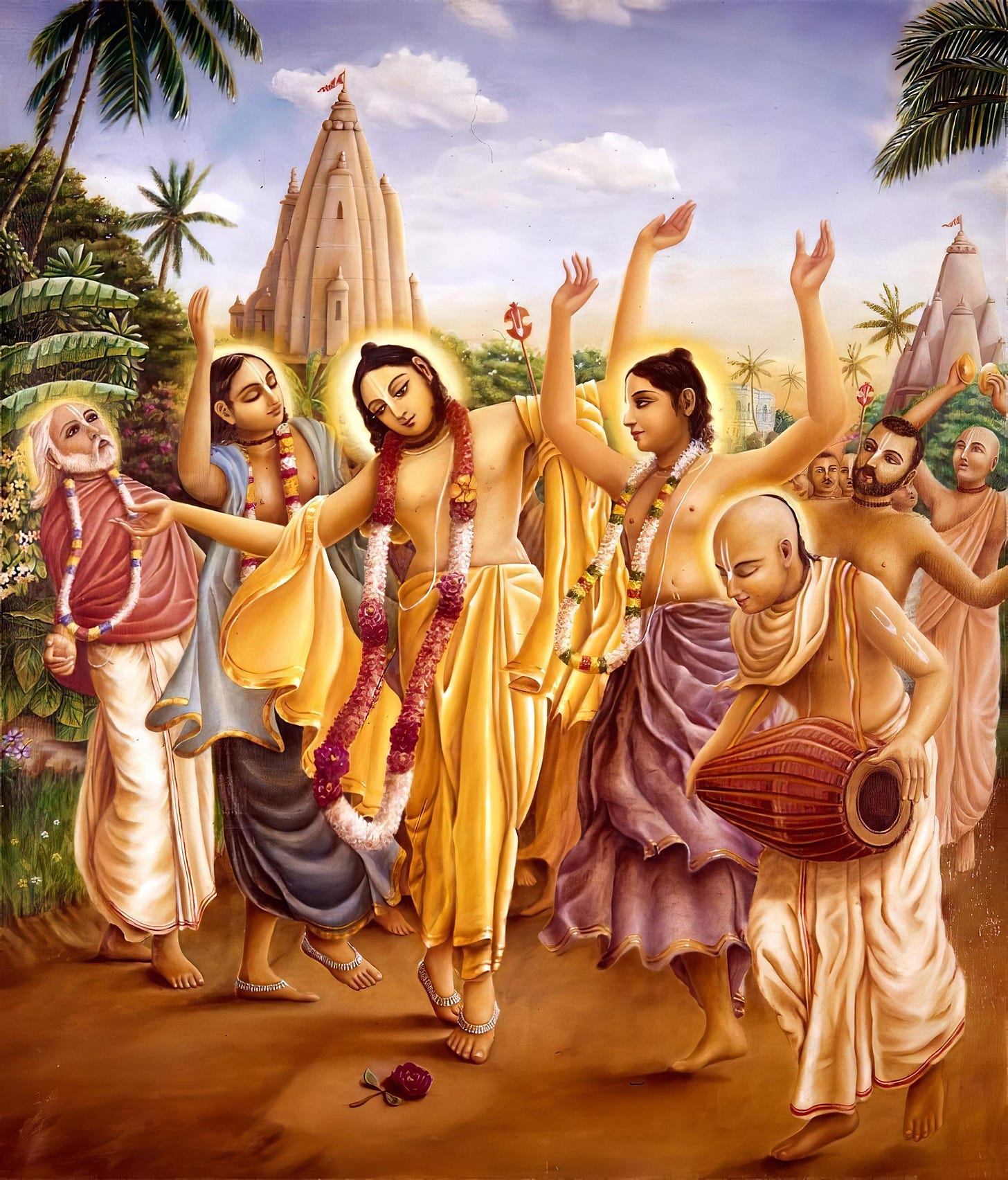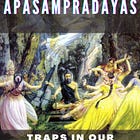A new sankirtana movement, started from scratch
How could the original movement of Mahāprabhu, where practically everyone was a pure devotee at the level of prema, degenerate into many apasampradayas, like the bauls?
When Sri Caitanya Mahāprabhu started His Sankirtana movement, he very quickly filled Navadvīpa with love of Godhead, which quickly overflowed and submerged the whole of India. At the time, not only were the direct associates of Mahāprabhu pure devotees, but also the distant associates, people who came into contact with them, the family members of the people who would come in contact with them, and even people who would come in contact with people who came in contact with them. In this way, Prema spread like a powerful virus, quickly taking over India.
However, just a few hundred years later, Vaishnavism had already degenerated into a conglomerate of sects that had little to do with the original movement of Sri Caitanya Mahāprabhu. Baulas were living degraded lives and chanting folk songs, just like hippies. Ativadis were worshiping Lord Jagannātha with the goal of becoming one with Him, Saki Bekis were dressing in saris and pretending to be Gopis while at the same time performing the most immoral acts, and so on.
How could the original movement, where practically everyone was a pure devotee at the level of prema, degenerate so badly? And if it went so wrong the first time, what is the possibility of transforming the current materialistic society into a society of pure devotees, starting the golden age that is predicted in the scriptures?
The best answer I got to this question is in the Vaishnava-kripa-prarthi, of Madhavananda Prabhu. There he mentions:
"There is a highly-respected sadhu-scholar who was born and lived in Nabadwip around 100 years named Kanupriya Goswami. Aside from being a respected Ayurvedic doctor who was the last person to treat Srila Thakur Bhaktivinode, Kanupriya was also famous as a nāma-parāyaṇa-sādhu or one who took one-pointed shelter of the holy name. Kanupriya wrote a number of books in Bengali including one wherein he addressed our question. In reply he stated “However, it is seen that the prema that was manifest at the time of Mahāprabhu is practically non-existent today. From the many signs it appears that Gaura’s mission is over.”
Kanupriya then notes that, Krsna was visible for 125 years, the last 100 years of Dvarapara-yuga and the first 25 of Kali-yuga. Kali could not enter in the first 25 years of this age because of Krsna’s presence. (See Bhag. 12.2.30 and 12.2.33) As soon as Krsna left then the symptoms of Kali appeared (see Bhag. 12.2.29). Kanupriya then notes that the symptoms that are supposed to manifest at the end of Kali-yuga are manifesting today after a mere 5,000 years. To support this he cites Bhagavatam 12.2.1-7.
According to the vision of Kanupriya Goswami the reason for this is that Kali could understand that this was a Dhanya-kali-yuga or rare Kali-yuga in which Mahāprabhu would appear. Realizing that Mahāprabhu's movement would negate all of his influence, Kali decided to give it his all quickly before Mahāprabhu’s movement deeply took off world-wide. According to Kanupriya we therefore see symptoms at this time, which should not manifest until the end of this yuga.
Kanupriya then observes that there are two aspects to the mission of Sri Chaitanya Mahāprabhu:
1) Any jiva who was present in the world during Mahāprabhu's manifest presence got liberation.
2) He left the means by which the future living beings in Kali-yuga would get prema-bhakti.
He then explains the five stages of a seed:
1) bīja-saṅgrahaḥ — gathering seeds.
2) āropaṇa — planting the seeds.
3) kaila — the seeds germinate.
4) aṅkura — the seeds sprout.
5) phalila — they gradually grow and fructify.
Kanupriya Goswami points out that many times a seed will stay unnoticed in the ground for a long time (sometimes for many years even) — seemingly not doing anything (apparently a failure). He says that the period we are in now of Mahaprabhu's movement is that time of the seeds germinating and beginning to sprout. He is confident as are our acaryas and contemporary saintly persons that prema will manifest in time."
This point made by Kanupriya, that all souls who were on the planet during the time of Mahāprabhu went back to Godhead, is mentioned in other passages. However, because it is so inconceivable,e we tend not to process it. However, when we accept it as a fact, everything becomes clear: All the pure devotees who got Prema from Mahāprabhu and other of his associates left, they all went back to Godhead. Just like Krsna took the inhabitants of Dvarka with Him, or Lord Rama took the citizens of Ayodhya, Sri Caitanya Mahāprabhu took everyone who got in contact with Him back to Godhead.
The world was then seamlessly repopulated with a new batch of souls, awakened from the Pradhana, and life continued as if nothing had happened. A new Sankirtana movement was thus started with the preaching of Srila Narotama Dasa Thakura, Shyamananda Prabhu, and others, and new souls started their path from zero, based just on the vani of Mahāprabhu and His associates. This vani represents the seeds from which future generations could also get prema.
When we take this point into consideration, all the unbonafide sects and deviations that were present by the time of Srila Bhaktivinoda Thākura make complete sense. These were souls making their beginner's mistakes in spiritual life, trying to figure out how to apply the elevated philosophy of Mahāprabhu that they couldn't fully comprehend. The true paramparā was maintained through a line of empowered ācāryas which sprouted from the original associates of Mahāprabhu, but outside this narrow line, corrupted disciplic successions and deviations were rampant.
From there, things were gradually being built, with the contributions of Srila Bhaktivinoda Thākura, Srila Bhaktisiddhānta Sarasvatī Thākura, and Srila Prabhupada being added, and the number of advanced devotees on the planet growing.
The saṅkīrtana movement has thus two phases. The first phase started with Mahāprabhu and was concluded with the withdrawal of his manifested pastimes. From there, a new batch started under the guidance of a new generation of preachers, under the guidance of the few associates of Mahāprabhu who remained on the planet. These were souls who started their Krsna consciousness from scratch and are by now practicing for a number of lives, with new souls starting the process at each generation. This wave has been growing since these times, and is now becoming bigger, with the millions of people who are currently practicing Krsna consciousness to some capacity. The older students are guiding the new students, and we may have a few associates of Mahāprabhu amongst us supervising things.
The movement of Mahāprabhu thus didn't degenerate after his disappearance, instead, a new movement was started from scratch based on his vani. This new movement has been developing since then, and may soon be ready for prime time. The Golden age may thus not be as far as we might think.
If you read this article to the end, give it a like. This makes Substack recommend it to more people.
Read also:






Hare Krishna Prabhu, very interesting explanation, Thank you.
If Adwaita Acharya prayed for the Lord to appear due to how degraded society had become, how are we to understand that all those souls received liberation? Did they achieve it despite their free will? If it was just due to mercy, is that not then unfair for those all the souls who didn't get that mercy (including us)?
Hari bol!